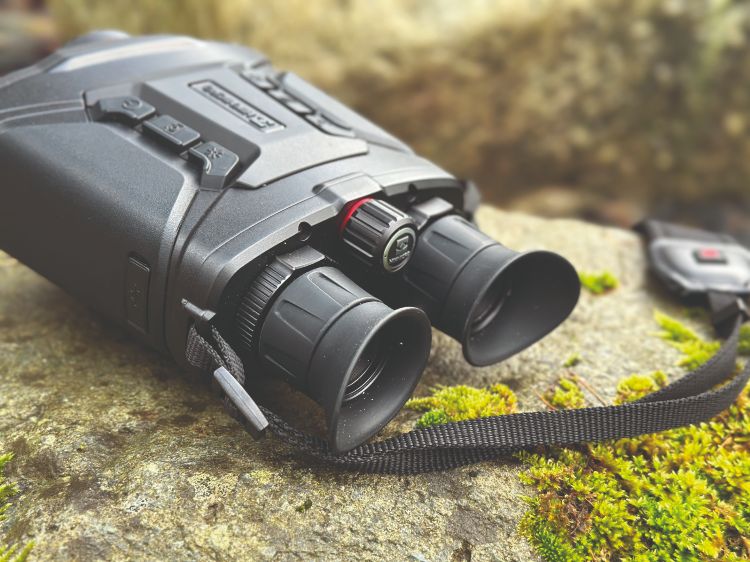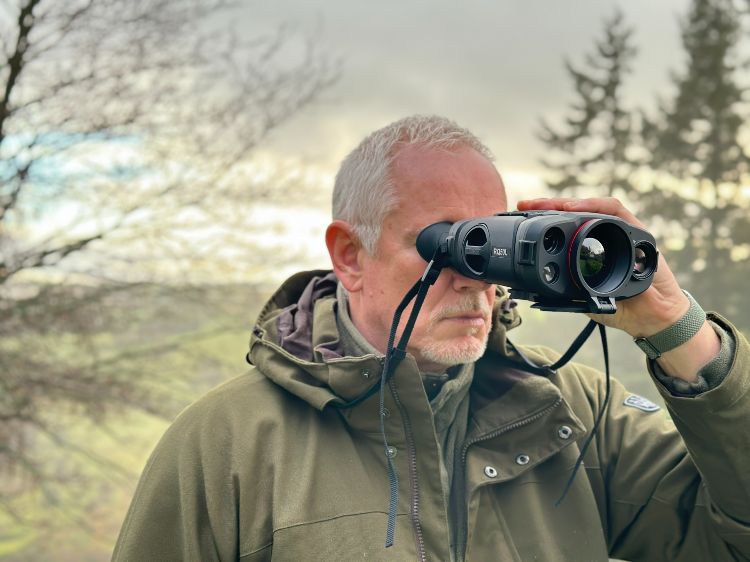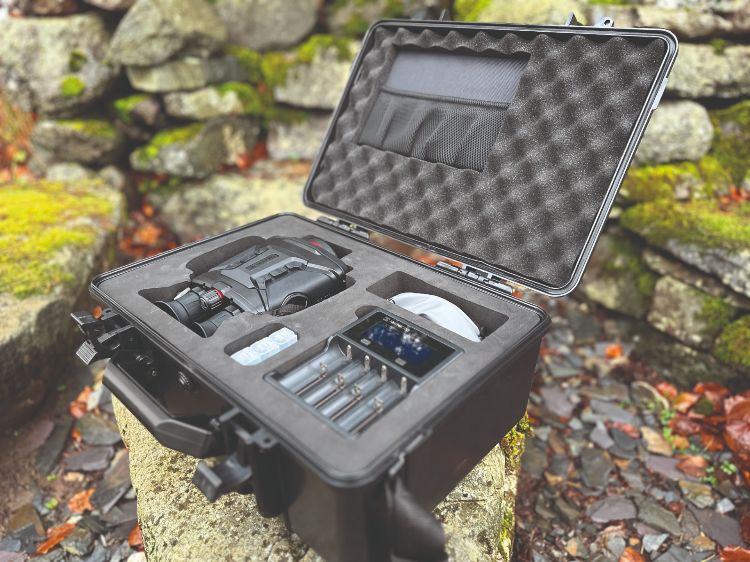The arrival of thermal spotters completely transformed hunting. Following their huge impact, the next obvious step was to apply the same tech to scopes, thereby making hunting completely covert and achievable in any weather, night or day. However, there is an Achilles heel…
The current crop of thermal sensors (even the 640x480 variants) are very low resolution compared with traditional day or IR optics. Weighing in at just 1.3 megapixels, their images are tiny – even a basic smartphone delivers 10-12MP.
Admittedly you don’t necessarily need super-high resolution if you’ve already identified your target, but there’s a very big difference between detection and identification, and it’s here that our old friend Achilles plonked his boot!
With almost any thermal you can easily track a fox coming in from way off. If you maintain contact and monitor its gait closely you can easily confirm what you’re looking at and simply hop over to a thermal scope, locate your target and pull the trigger. However, it’s not always that simple.
What if you lose sight of the fox behind cover and then ‘something’ appears nearby. Are you still confident enough to take the shot? What if you scan a field and an animal is there but clamped down? Is it a fox or the farm cat? That can be very difficult to say at 150m with today’s thermals, especially when viewing an animal in partial cover.
The solution, for me at least, is the tried and trusted combination of a thermal for spotting and an IR scope for the rifle. I’ve shot many times with a fully thermal rig and have had great success, but I’ve also had to pass on a few opportunities because it was impossible to be certain of the quarry. More than once I’ve asked a shooting buddy with an IR scope to confirm the quarry before taking a shot.
The dilemma of whether to carry two pieces of equipment or suffer the limitations of one is now over with the arrival of the HikMicro Raptor RQ50L thermal binoculars. And this isn’t all about thermal, as this is a device that can deliver no matter what optic you’re running on your rifle.
 Core functionality
Core functionality
As you’ve probably gathered, courtesy of the massive f0.9 50mm lens, thermal is the Raptor’s core skill – but it adds a few extras that make it truly unique. We have thermal, full-colour daytime optical, night-time IR, plus a fusion mode that blends thermal and optical signals to create a hybrid IR/thermal image. It also includes a built-in 850nm IR illuminator and a laser rangefinder.
In short, it has every spotting and ranging tool you could possibly need all under one roof. I’ll start by looking at the individual elements and then we’ll explore the unit as a whole.
On a good thermal day, the thermal image is exceptional – as good as or better than anything else on the market. Gradients are smooth, as you’d expect. The great news is that the penny has finally dropped for the boffins at HikMicro, who long seem to have been labouring under the delusion that detection is everything. Long-range detection is great, but in the field it’s identification that makes the real difference.
The lack of balance within the image of previous products has been a major bugbear of mine with both HikMicro and indeed iRay releases. It’s great that a target sticks out like a sore thumb but if you can’t make out the environment around it it’s far from ideal.
With a <20mK NETD sensor, HikMicro should dominate in terms of image quality and that’s finally the case with the Raptor, which has been calibrated perfectly and delivers an outstanding and well-balanced image on the excellent, large and high-resolution internal display. On a poor thermal day I think the Pulsar Merger/Accolade may still have the edge, but without having that and the Raptor side by side, it’s impossible to offer a conclusive opinion.
 Regardless of the conditions, the Raptor still has several additional aces up its sleeve. It has all the usual thermal colour palettes, but there’s also fusion mode, which can, on occasion, dramatically enhance a relatively poor thermal picture. It’s not perfect, but it’s an option you always have in your arsenal. If the thermal image is unclear, try fusion. If you still can’t get a positive ID, try IR mode or optical. This amazing flexibility is the real strength of the Raptor.
Regardless of the conditions, the Raptor still has several additional aces up its sleeve. It has all the usual thermal colour palettes, but there’s also fusion mode, which can, on occasion, dramatically enhance a relatively poor thermal picture. It’s not perfect, but it’s an option you always have in your arsenal. If the thermal image is unclear, try fusion. If you still can’t get a positive ID, try IR mode or optical. This amazing flexibility is the real strength of the Raptor.
Fusion mode can be great in certain circumstances. It enhances man-made structures well – the outline of buildings and vehicles, etc – but there is some ghosting to contend with, especially at close range. This is to be expected as the IR/optical lenses are offset from the main thermal lens, which doesn’t appear to be corrected particularly well by the software. Having said that, on occasion it can offer dramatic improvements. For me it’s a useful option rather than a key selling point.
The daytime optical image was a pleasant surprise. Yes, it does look digital – which it obviously is. The image is well balanced and works particularly well in gloomy conditions. On the first night of testing it was a full moon and the Raptor still picked up colours in the scene past last light and in fact throughout the night.
It works well as an alternative to traditional binos. You don’t get the same image quality, obviously, but it can pick out and ID quarry over a kilometre away without any difficulty during the day. The image stabilisation is good, although the available mag range is a bit silly, offering up 16x based on the 3.5x base mag. The 16x zoom is unusable freehand, although you can tripod mount the Raptor. However, it’s so pixelated it doesn’t really have a practical application. Even the 8x is pretty shaky, but at base mag, 2x and 4x it’s impressive, and at 4x it still delivers 14x in terms of real-world magnification.
The auto-adjusting IR is the final piece of the optics puzzle and once again it’s very impressive. HikMicro claim a reach of 400m but on a moonlit night you get considerably more than that. It’s the perfect partner for the thermal/fusion image. If you’re not 100% certain in thermal mode, just press a button and IR comes to your rescue. This thermal-to-IR option will definitely be the most important feature for night hunters.
The icing on the cake is, of course, a built in LRF. The accompanying bumf claims 1,000m, which it will do on a reflective/solid structure. In real-world applications and on open ground it reliably pings to 650m every time and can stretch to 850m, occasionally requiring a couple of attempts. For typical shooting applications it’s more than enough, plus it’s fast and also offers a scanning mode.
 And finally…
And finally…
This has been very much a whistle-stop tour of the Raptor, and there’s plenty more functionality under the bonnet. I hope to take a deep dive into the device once this demo unit has done the rounds. You’d imagine it might be tricky to control, but the six buttons up top make it very easy to drive and after a trip or two you’ll be flying through the features effortlessly.
In short, this is a landmark product that delivers almost everything I want from a spotter in a single unit. It’s only January, but I suspect the Raptor will be one of the most important releases of 2023. If that’s not high praise, I don’t know what is!
Is it perfect?
So are there any issues? Yes, a few. It’s big and it’s heavy, weighing in at a little over 1.2kg fully loaded with its three 18650 batteries. Although it ships with a neck strap and side handles I’d definitely recommend a bino harness for extended use. The Raptor just about fits into the new Härkila bino harness but any open harness would be fine.
The zoom function is very annoying. HikMicro flags its ‘smooth zoom’ as a selling point, but in fact it’s just an irritation. It zooms in stages from base mag to 16x, but it takes ages to cycle through and back to base magnification. It’s has to be an easy firmware fix to simply skip from one mag level to the next. Let’s hope that’s an option via the next firmware update. On the plus side the PIP function means the tedium of ‘zooming’ can often be avoided.
Battery life is stated as eight hours; I think that’s pretty optimistic. I got five to six hours on average during testing, but I was really hammering all the features. The unit does ship with six 18650s as standard and for extended trips you would definitely want to carry some spares.
For me the base mag of 3.5 is too high. I prefer 2.0/2.5, which allows the unit to be employed at close quarters as well as over open fields. If you shoot primarily in open country the 3.5x is fine, but around the yard and in woodland it does feel cramped. I would not recommend the 384x288 version of the Raptor for close-quarters work, as that variant has a whopping base mag of 5.5x.
Would any of the above put me off buying one? Absolutely not! It’s not perfect, but it’s the only device on the market that pulls all the spotting and ranging essentials together into a single package. The only thing that puts me off is the asking price. It’s still cheaper than its primary competitor and it does offer a lot more functionality. But for me, and many others, £4k puts it way out of my price bracket.
Contact
Scott Country International
Tech specs
640x512 12 micron thermal sensor (NETD <20mk)
Frame rate: 25Hz
High sensitivity <20mK NETD
Auto power save when not scanning
Super-large aperture f/0.9 thermal lens
2560x1440 high-res CMOS day and night vision
Built-in 850nm IR illuminator
Laser rangefinder with 1,000m measuring distance
Thermal mode, optical mode and image fusion mode
1024x768 HD display
Wi-fi app connectivity – update pending
Video/pic recording and built-in 64GB memory
Internal pic/video playback
Battery run time (up to) 8 hours (3 x 18650 batteries)